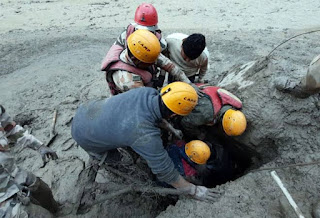Uttarakhand Glasiear Brust,Rescue Team to Work Overnight ,What is the opinions of the experts
 |
| eruption were workers of two hydropower projects in Chamoli district of Uttarakhand Chamoli Glasiear |
Uttarakhand Glasiear Brust, rescue teams, trapped in the rubble of the war activities began to work overnight to rescue people. Most of the victims of yesterday's avalanche eruption were workers of two hydropower projects in Chamoli district of Uttarakhand, which were damaged by the sea ice.
Disaster footage on Sunday showed a narrow ghat created by a fast-moving wall of water and rocks scattering below and shattering a dam on a small hydroelectric project on the river bank, wiping out trees and people, before rising to the bottom of the river.
Ashok Kumar, a senior Uttarakhand police official, said on Monday that the floods had displaced about 2,500 people in 13 villages.
On Monday, rescue teams began clearing mud and debris from a tunnel at the state-
owned hydropower project, with about 30 to 35 workers feared trapped inside.
According to Reuters, the teams were able to drill through 150 meters of the 2.5-kilometer (1.5-mile) long tunnel. On Sunday, rescuers rescued 12 people trapped in another small tunnel at the same site, Kumar said.
The cause of the avalanche eruption has been questioned by many, pointing to the high level of construction on the river banks of the state, connecting an increasing number of hydroelectric dams, projects and infrastructure in recent years.
Kumar, a Uttarakhand police officer, said, "It was a one-time event. The glacier broke and ... all the debris came down and flooded the power project," he said.
Memories of a similar catastrophic incident on Sunday came back in 2013, when the region's chief minister called it a "Himalayan tsunami." About 6,000 people died in the floods, according to Reuters.
Massive damage
At a press conference on Sunday, Chief Minister Trivendra Singh Rawat said that "Uttarakhand has witnessed a catastrophic catastrophe" and the state "expected catastrophic damage to human life and infrastructure."
Around 10 a.m. local time when the Nanda Devi glacier erupted and the water receded into the Dhauli Ganga river valley which is about 500 km (310) miles north of Delhi.
Most of the damage caused by the destruction was centered on two hydropower projects. The Indian Ministry of Power said in a statement on Monday that the Rishiganga Power Project - a small dam of 13.2 MW - was completely washed away.
The state chief minister said 35 people were working at the plant when it was swept away by the water and "about 29 to 30 people are missing."
Authorities issued an emergency evacuation notice to people living on the banks of the Alkananda River due to rising water levels.
In the aftermath of the flooding in the valley, they caused extensive damage to the second and much larger 520 MW hydro project under construction, about 5 km away from the second project. About 176 workers were working on the site of Tapovan Vishnugarh Hydropower Project, where two tunnels are present and it is owned by NTPC, India's largest power utility
Rescuers are fighting to reach them, but the surrounding road is covered in rubble. Another 30 workers are likely to be trapped in the cave.
An eyewitness told Reuters that dust, rocks and water snow had hit without warning.
"It came very quickly, there was no time to warn anyone," Sanjay Singh Rana, an eyewitness living on the upper reaches of the river in Reni village in Uttarakhand, told Reuters by phone. "I felt like even we would be swept away."
Indian Prime Minister Narendra Modi sent a message of support in the wake of the disaster. "I am regularly monitoring the unfortunate situation in Uttarakhand," he tweeted.
"India stands with Uttarakhand and the country prays for the safety of all there. Liaison with the higher authorities is ongoing. And the NDRF (National Disaster Response Force) has received updates on deployment, rescue and relief operations."
What do the experts think?
Experts say Himsagar was a ‘climate event’
Although experts say the exact cause of Sunday's snowfall is too early to say, they say human-induced global warming is certainly a major cause.
Research Director of the Indian School of Business, Bharti Institute of Public Policy. “It looks like a climate change event,” said Ankal Prakash.
A 2019 climate-related report revealed, “Climate change is how the region has undergone a change that will increase the frequency and magnitude of natural disasters.
According to the revelation, the area where the snowfall and floods occurred is extremely remote and a few villages spread across the mountains and valleys where it may take a few days to reach.
These places need "basic amenities like infrastructure, water, roads and sanitation," Prakash said, adding that "we need development here because these are some of the poorest areas."
However, what kind of developments and projects should be created in the discussion and how pleasant it will be for the environment is under consideration.
Post a Comment
Don't allow spam link